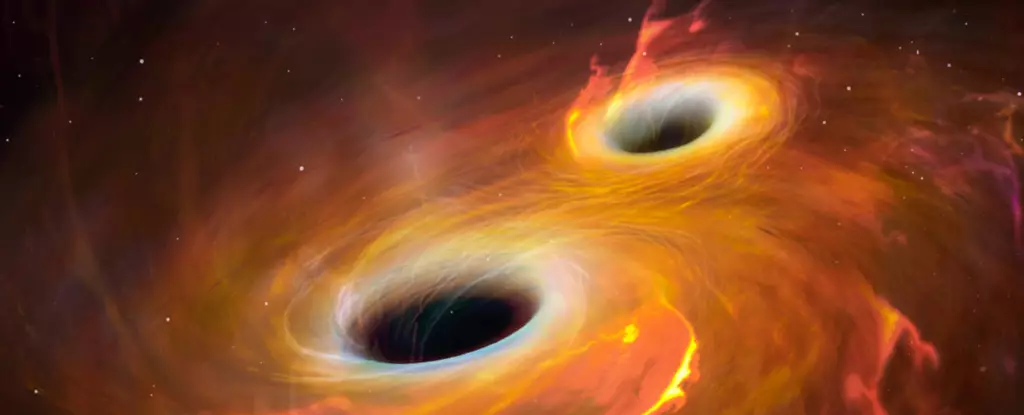At the heart of our galaxy, a tempest brews—a supermassive black hole known as Sagittarius A* surrounded by a turbulent milieu of stellar phenomena. Young stars flicker to life, gas and dust swirl in a cosmic dance, and clusters of stellar-mass black holes lurk in the shadows. This intricate region is obscured from our sight by an inky veil of interstellar debris, shrouding its secrets in darkness. Visible light may fail to penetrate these cosmic layers, but infrared and radio observations offer a tantalizing glimpse into this chaotic center. Yet, as we endeavor to understand this galactic hub, one question plagues astronomers: How many stellar-mass black holes reside near Sagittarius A*?
Challenging Traditional Models
Traditional theories of star formation present a stark contrast to emerging research findings. Previous models hinted at the existence of a modest population of about 300 stellar-mass black holes in the galactic core’s vicinity—an estimation that stands in stark opposition to fresh discoveries. Researchers have begun to propose bolder ideas, suggesting that the very presence of Sagittarius A* may have catalyzed an explosive birth of countless stellar-mass black holes through gravitational interactions and supernova events. This raises the stakes in our understanding of black hole formation and abundance.
A recent study published in “Astronomy & Astrophysics” introduces a provocative new framework, aptly termed the ‘star grinder,’ to explain the apparent overabundance of black holes surrounding Sagittarius A*. This model is grounded in the observation that the central region is rich in gas and dust, creating a fertile environment for massive stars, particularly O-type and B-type stars. With their short lifespans culminating in cataclysmic supernovae, the remnants of these stars inevitably lead to the formation of black holes. A cascade effect ensues: as stars complete their life cycles, the remnants not only contribute to new star formations but also accumulate black holes over time, suggesting a far more populated environment than we initially believed.
The Case for Chaos: Star-Grinding Dynamics
The implications of the star grinder model extend beyond a mere increase in black hole population; they propose a dynamic, chaotic evolutionary cycle. As more stars are born and subsequently perish, the center becomes a veritable black hole factory, with potential collisions between stars and black holes becoming not just a possibility, but a likely scenario. The notion of stellar encounters shifting from rarity to commonplace poses profound questions about the nature of cosmic evolution.
To understand this bustling environment, researchers have turned to a vital statistical method known as collision time. This metric estimates the average duration before a star collides with a black hole based on their respective density and size. A higher density not only increases the likelihood of collisions but also impacts the evolutionary path of the stars in that region. By analyzing collision times across various distributions, researchers are beginning to build a clearer picture of the gravitational chess game at work near Sagittarius A*.
The Collision Conundrum: Insights from Observation
When observations of the largest O-type stars at the center of the Milky Way contradicted expectations of their local population, it became evident that these giants were falling victim to the dangers posed by an unyielding black hole environment. The lower than anticipated number of O-type stars suggested they were frequently involved in collisions, aligning with the predictions posed by the star grinder model. Mannings among smaller B-type stars support the notion that they face milder fates, as their size makes their interactions with black holes less likely.
The study sheds light on the substantial possibility that there could be around 100 million stellar-mass black holes per cubic parsec in the vicinity of Sagittarius A*. Such astounding numbers catalyze a revision of our understanding regarding the galactic core’s dynamics. Herein lies the beauty of science: each revelation sparks deeper inquiry into the cosmos’ underlying mechanics.
Hypervelocity Stars: Cosmic Messengers
One of the most exhilarating ramifications of this burgeoning knowledge is its ability to account for the mysterious hypervelocity stars that zip through the galactic halo at astonishing speeds. These stars seem destined to escape the Milky Way altogether, and their existence can be explained through close encounters with black holes. As the population of black holes escalates, the likelihood of stars experiencing gravitational slingshots further accentuates the cosmic tumult occurring at the galaxy’s heart, linking the microcosmic dance of black holes to the grander structures of our universe.
Thus, as we peel away the layers of our galaxy’s core, we gain invaluable insights which, though occasionally daunting, hold the promise of a greater understanding of black holes and their cosmic roles. In the fabric of our galaxy, it seems the dance between stars and black holes is only just beginning.

